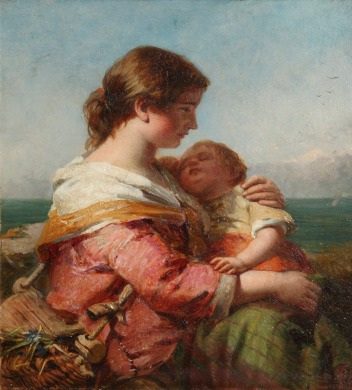
Mothering Sunday was once the day on which people would visit their “mother” church, but has now become an occasion for honouring the mothers of children.

Mothering Sunday was once the day on which people would visit their “mother” church, but has now become an occasion for honouring the mothers of children.

The young Henry Stacy Marks was a keen artist and showed such little aptitude for business that his father preferred him to go to art school than to join the family firm of solicitors. It turned out to be a prescient decision as the business failed and Marks had to support not only his wife but his mother and three younger brothers on the proceeds of his art.
Visitors to Sudley House near Liverpool are able to enjoy several examples of the work of the great British landscape painter JMW Turner. The Wreck Buoy is the shining example; it captures Turner’s obsession with the sea at the height of his power. Whilst a controversial figure in his own lifetime, his reputation as a master is now assured. Known as the great ‘painter of light’ Turner’s influence on the later Impressionist movement is now firmly acknowledged.
The painting’s impressive dimensions allow the viewer to ruminate on both the majesty and ferocity of nature. Its location in the house of ship owner and merchant George Holt reminds us of Liverpool’s reliance on the sea for trade and prosperity. Yet for all of Turner’s ability to romanticise the stormy weather that surrounds our small island nation, this painting represents a much darker side. The wreck buoy floats atop the unrelenting wave warning sailors of the danger beneath. It marks the spot where the bodies of their peers lie. The rainbow arching over the horizon points down towards the buoy, its vibrant colours have been drained by the storm and are all but lost on the canvas. It is a stark reminder of the futility of human endeavour.
“It was one of those March days when the sun shines hot and the wind blows cold: when it is summer in the light, and winter in the shade” wrote Charles Dickens in Great Expectations, a notion which is beautifully encapsulated in this painting.
We are presented with a beautiful maiden, dressed elegantly in medieval costume, sitting inside a walled garden. Medievalism was a popular theme in Victorian art; depictions of chivalry and romance were a regular source of inspiration by writers and painters of the era. The luxurious fabric of the dress gives the artist the opportunity to demonstrate his skill and gives imbues the painting with a timeless, ageless quality. The young maiden’s blue dress is reminiscent of that often worn by the Virgin Mary in paintings; the white head dress further substantiates this idea. (more…)
February is the month we traditionally express our love to others and patiently wait hoping those feelings will be reciprocated.
The subject matter of this month’s painting is summed up eloquently by its poetic title, ‘Her eyes are with her heart, and that is far away.’ A beautiful maiden leans against a piece of ornately engraved marble. The girl is dressed in loose fitting white robes, which might normally suggest innocence. Yet they clutch her body in ways just enough to suggest that she might not be quite as innocent as we first imagine. She looks to the ground, unaware of or unconcerned by our presence. (more…)
On February 14th romantics all over the world will have penned sweet missives to their loved ones, hoping that their sentiments will be reciprocated. A similar circumstance is represented by John Melhuish Strudwick in the painting ‘O Swallow, Swallow’ currently on display at Sudley House in Aigburth, Liverpool. It is loosely based on part of the poem ‘The Princess’ by Alfred Lord Tennyson whose words inspired many painters working in the latter half of the 19th century.

Strudwick was an unpromising art student until he met Edward Burne-Jones to whom he became a studio assistant. The influence of Burne-Jones, who had close links with the pre-Raphaelite movement and the decorative arts of William Morris, is clearly evident in this painting.